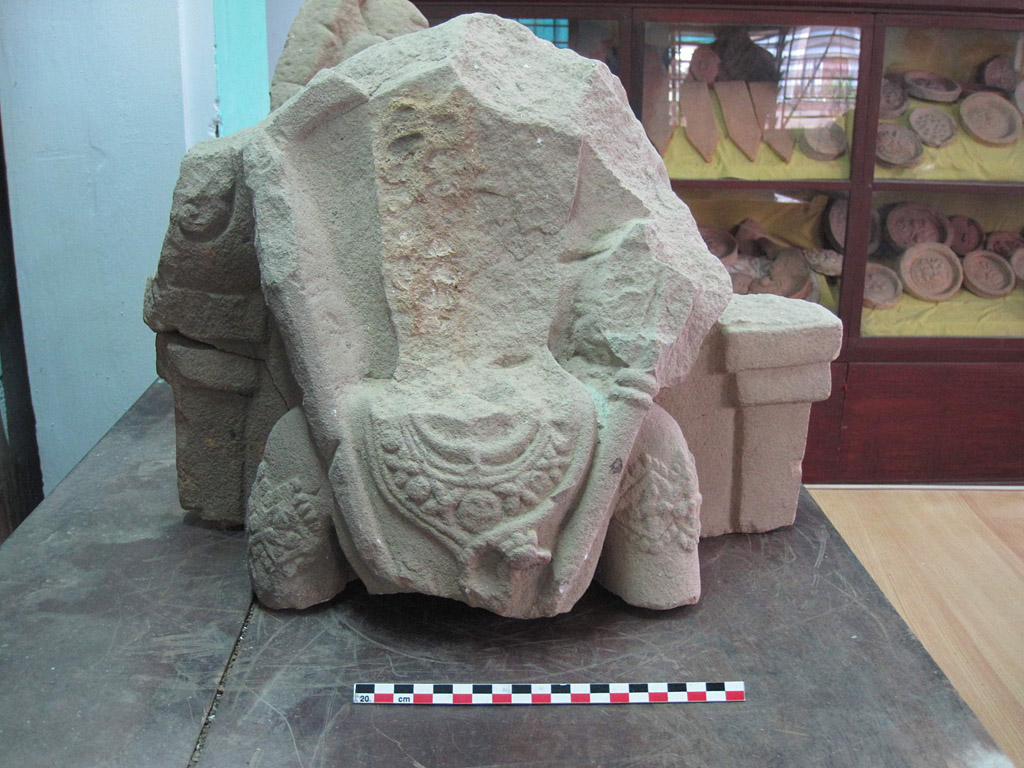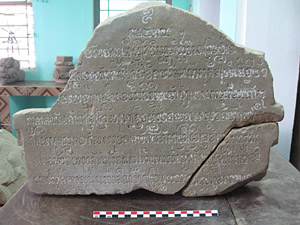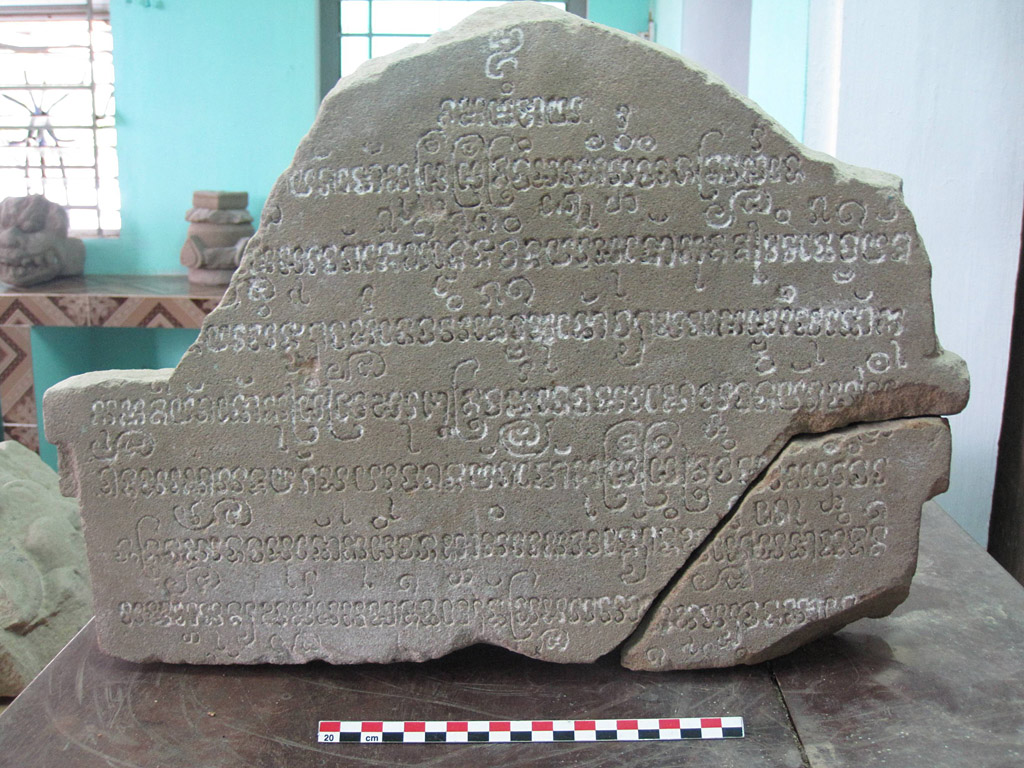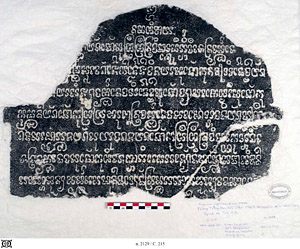Corpus of the Inscriptions of Campā






C. 215 Broken statue of Śiva from Chiêm Sơn
Please note: you are reviewing a preprint version of this publication. Contents here may change significantly in future versions. Scholars with specific interests are urged to consult all cited bibliography before using our texts and translations or drawing other significant conclusions.
Support Back of the upper part of a broken sculptural stela of Śiva; sandstone; h. 34 cm × w. 46.5 × d. 20.5.
Text Remains of eight lines on one face written in Old Cam.
Date 14th century, possibly 1365 Śaka (15th c., possibly 1443/4 CE).
Origin Valley of Chiêm Sơn Tây (Quảng Nam).
This piece was found by a local catholic at the mound called Chùa Vua (or Chùa Voi) in the Chiêm Sơn Tây valley. According to local sources, this happened most probably between 1985 and 1989, but in any case not before 1982 when a new agricultural program encouraged the digging of new fields at Trà Kiệu and Chiem Sơn. The finder brought the piece to the church in Trà Kiệu.1 The inscription was first observed in the Trà Kiệu church before 1991, as reported in Trần Kỳ Phương & Nguyễn Van Phu 1991: 220.2 It was observed there again, and photographed, by W.A. Southworth in 1993. Two photographs of the stela taken by Marie-Christine Duflos and V. Crombé were used to illustrate a general article by Anne-Valérie Schweyer in 2003, where it was given the caption “Stèle inédite du XIe-XIIe siècles … Musée de Trà Kiêu” (Schweyer 2003: 18). We identified the stone in the Phòng Trưng Bày Văn Hóa Chăm (Exhibition room of Cam culture), in the Nhà Xứ presbytery at the Trà Kiệu church in 2011.
Edition(s) First published, without translation, in Schweyer 2008a: 228. The text is re-edited here from the stone and the EFEO estampage.
Facsimile
- Estampage: EFEO n. 2129
The following text was edited by Arlo Griffiths.
(2) [va] {4}(r)mma pūra urām̃ ṅauk· glauṅ· vijaya pu pom̃ ku nan· ticauvv· yām̃
(3) [pom̃ ku śrī] (ja)ya siṅhavarmmadeva ticauvv· pu pom̃ vyā parameśvarī pu pom̃ ku
(4) kumman· yām̃ pom̃ ku śrī braṣu indravarmmadeva paramotbhava di yām̃ pu śrī
(5) rājaparamātmaja yām̃ pu yuvarāja yām̃ pom̃ ku śrī śrīndraviṣṇukīrtti vīra-
(6) bhadravarmmadeva pu pom̃ ku śivabhaktātireka tadyom̃ di dharmmopapāti jan·
(7) samastapunyadharmma makapun· (th)al(y)a (th)am̃krammasatā(ka) dhūppa vada kā(la) {1}
(8)
1 viṣṇukīrtti ◇ viṣṇumūrtti Schweyer. — 2 [va] {4}(r)mma pūra ◇ [va ca]mpapūra Schweyer. — nan· ◇ nagara Schweyer. — 3 [pom̃ ku śrī] (ja)ya siṅhavarmmadeva ◇ [ja]ya siṅhavarmmadeva Schweyer. There is definitely place for several more syllables than Schweyer assumes, and comparison with other inscriptions shows that pom̃ ku śrī is a fixed part of the royal title. — vyā parameśvarī ◇ this sequence was not read by Schweyer, although the letters are clear, and the same sequence figures in C. 11 A, l. 3 and C. 22 A, l. 3. — 4 paramotbhava di ◇ paramottara niy Schweyer. For paramodbhava (of which paramotbhava represents a sloppy spelling), see C. 11 A, l. 3 and C. 31 A1, l. 2 (a form paramottara is not attested, and the reading is clearly °va, not °ra). — 5 rājaparamātmaja ◇ rājaparamā. . . Schweyer. The letters unread by Schweyer are clear. — pu yuvarāja ◇ pov ku yubarāja Schweyer. — viṣṇukīrtti ◇ viṣṇumūrtti Schweyer. — 6-7 śivabhaktātireka ◇ Schweyer does not transliterate any further akṣaras after śiva°.
Translation
Om. Homage to Śiva! ... Y.P.K. Śrī Śrīndra Viṣṇukīrti Vīrabhadravarmadeva ... [who hails from] the capital, man Ṅauk Glauṅ Vijaya. That P.P.K. was the grandson of Y.P.K. Śrī Jaya Siṁhavarmadeva, the grandson of P.P.V. Parameśvarī P.P.K, the nephew of Y.P.K. Śrī Vṛṣu Indravarmadeva, of supreme birth among the illustrious lords supreme princes. [He was] milord the heir apparent. Y.P.K. Śrī Śrīndra Viṣṇukīrti Vīrabhadravarmadeva P.P.K., of unsurpassed devotion to Śiva, faithful to the production of dharma, carried out all meritorious gifts (dharma), such as: ... incense ...
Commentary
Notes
- Our first source was Đoàn Quang Dân (quangdanphaolo@yahoo.com) of the Nhà Xứ presbytary, church of Trà Kiệu. Our second source was Father Anthony Nguyễn Trường Thăng, Hoi An Catholic Church (Nhà thờ Công Giáo Hội An), số 2 Nguyễn Trường Tộ http://antontruongthang.wordpress.com/. In June 1975 he arrived at Trà Kiệu and began collecting Cham artefacts as a hobby. At the end of 1989 he was transferred to Ðà Nẵng, before spending 3 years in Paris between 1994 and 1997. He then worked in Thăng Bình until 2006, when he began his current station in Hội An.
- “In the collection of Father Nguyễn Trường Thăng at the Trà Kiệu church are currently preserved two heads from small statues, one piece of a stela in old Cham script, and many stone antefixes (pièces d’accent) decorated with flower and leaf designs. All of them were discovered at Gò Chùa Vua during the last few years” (“Trong sưu tập của Linh mục Nguyễn Trường Thăng tại nhà thờ Trà Kiệu, hiện cất giữ hai đầu tượng nhỏ, một mảnh bia chữ Chăm cổ, và nhiều tai đá (pièce d’accent) trang trí hình hoa lá. Tất cả đều tìm thấy tại Gò Chùa Vua trong những năm vừa qua”).



The iconography of what remains of the sculpture seems somewhat comparable with that seen in the sculpture whose back bears the inscription C. 42 from Drang Lai, which dates to the same period. Another inscription (C. 161) is engraved on the back of the lower part of a broken statue of Śiva. The god’s torso is there not preserved, but what is preserved of the lap of the deity and of his mount is very comparable to the Śiva from Drang Lai, bearing on its back C. 42, and so this piece may be considered to have been a comparable statue of Śiva. Moreover, this fragment of a Śiva was found in the valley Chiêm Sơn near Trà Kiệu.
In other words, we have two contemporary fragments of inscriptions, one engraved on the upper back, the other on the lower back of a sculpture, both of these fragments found in Chiêm Sơn; the one fragment shows the torso of a possible Śiva, the other the lap of a deity sitting on a bull, i.e. almost certainly Śiva. We are very tempted to consider that these two inscriptions, C. 161 and C. 215, originally belonged together as top and bottom. The measurements of the stones would seem to allow this hypothesis, although both fragments have suffered a lot precisely in the place where the pieces would have been joined, so it is hard to get any certainty from measurement, and it is not likely that physically trying to join the two pieces would yield clear confirmation either. We have measured the size of the letters of the two inscriptions, and the result was some dissimilarity in size, so that we remain in doubt about this hypothesis.